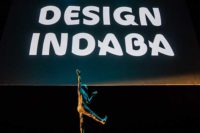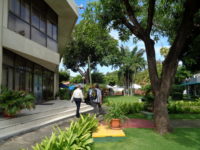For three days at the end of September, a group of students and professionals gathered in the Teatro Nacional in the old quarter of San Salvador for the 11th Mundaneum conference on architecture.
The biennial conference was conceived in 1998 by architects Alvaro Rojas of Costa Rica, Guillermo Honles of El Salvador, Teddy Cruz of California, and Daniel Rubio of Mexico, who identified that there were few opportunities in Central America for designers to gather and share ideas. “We made a promise to create an event so that important people would come to our countries and speak, sharing the knowledge of the world in one place,” says Rojas, who had founded a small architecture school, UniDis, in San José in 1993, which disbanded in 2009.
The decision to hold this year’s gathering in San Salvador was a long-held desire of Honles, who hails from the city, and who now is located in California. In planning the event (which, over the years, has been held in a variety of locations, from Costa Rica to Nicaragua to Argentina), he and Rojas worked with local organization, the Carrot Concept, a design collective formed in part by Salvadoran architects José Roberto Paredes and Guillermo Altamirano. The choice of El Salvador was perhaps an unlikely one, given the strife the country has suffered in the wake of its civil war, which ended in 1992. As a venue, the group was able to procure the city’s National Theater, dating to 1917, which was designed by French architect Daniel Beylard in the French Renaissance style. This lovely period piece makes a grand gesture against the backdrop of the deteriorated old city, and was an apt location to assemble a group dedicated to the practice of architecture.
Many of the university students in attendance from the handful of the country’s architecture programs had never before attended a design conference; as an initiation, this event was indeed a tour de force. True to the original mission for the Mundaneum, it brought together in one place, for an extended exchange of ideas, a collection of important architects from Latin America and beyond. Local architects were represented by the organizers and Eva Hinds, while those from the U.S. included Los Angeles’ Ming Fung and Craig Hodgetts; Denise Hoffman Brandt, director of the City College of New York’s Graduate Landscape Architecture Program; and landscape architect Mia Lehrer, a Salvadoran now based in L.A. Representing various corners of Latin America, speakers also included Ana María Durán (Quito), Jorge Pérez Jaramillo (Medellín), John Osborne (San José and Los Angeles), Mónica Bertolino (Córdoba, Argentina) Patrick Dillon (Panamá), Cazú Zegers (Santiago), and Mauricio Rojas (Bogotá). The founders of CUAC Arquitectura—one of Record’s 2016 Vanguard firms—Tomás García Píriz and Javier Castellano Pulido attended from Granada, Spain.
Over the course of three days, these designers discussed a range of ideas and built work just as diverse as the various locales in which they practice. Underscoring the rarity of such an event in San Salvador, the conference garnered significant coverage in the local press, as well as a shout-out on one of the city’s radio stations. As the Mundaneum set out to do, it delivered a bit of the outside world of design to the doorstep of a community with few outside connections, encouraging attendees to engage, investigate, and question. And, as Rojas pointed out, it demonstrated that “you don’t necessarily have to look to the U.S. or Europe for ideas.”
The next Mundaneum conference will travel further afield, gathering in 2018 in Granada, Spain.






